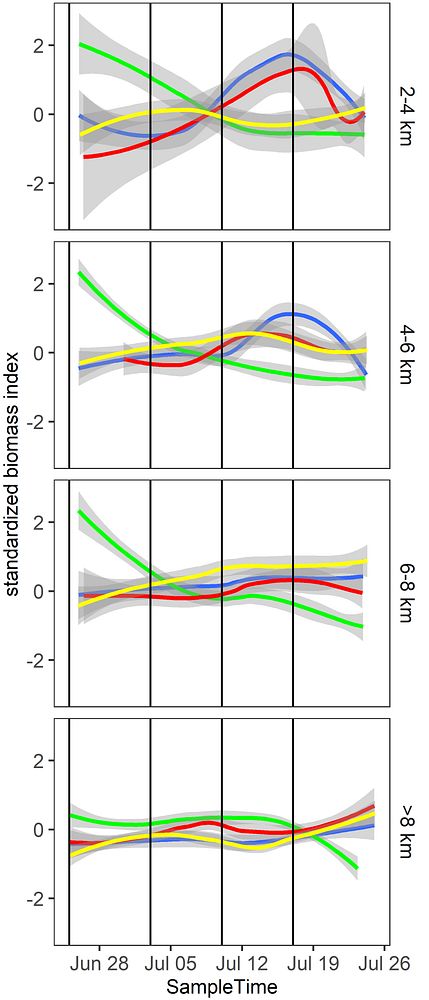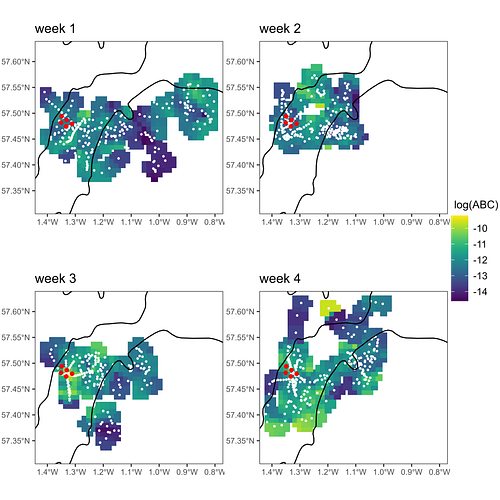26. september 2023 nyhet
By Virginie Ramasco, Trude Borch and Lionel Camus // Akvaplan-niva
To reduce reliance on fossil fuels, wind parks have been established in coastal areas. Besides providing renewable energy, these installations may benefit biodiversity by serving as artificial reefs that marine organisms can colonise. Could floating wind parks in offshore waters offer the same conditions?
In Europe, extensive activity is currently underway to produce more energy from renewable sources. The overall aim is to reduce greenhouse gas emissions and increase energy security in times of political turbulence in Europe. Norway has promised both to cut its own emissions and to contribute with renewables to the European energy market, and the government has signalled that ocean wind development has high priority.
It is important that Norway, in its expansion into offshore wind, operates in line with its international obligations to protect biological diversity and maintain sound ocean management. As part of this, Norway is obliged to report environmental status under the European Union’s Marine Strategy Framework Directive. This includes reporting on parameters such as the environmental status of the seabed and marine species, underwater noise, and other disturbances. such as electromagnetic fields. These reporting systems require new environmental baselines. One must also select an environmental monitoring regime before and during operation.
Pilot project
This is the background for a pilot project to test the use of autonomous vehicles and remote sensing technology to study whether the Equinor offshore wind park, Hywind Scotland, has a reef effect on fish.The effect of fixed installations at sea on fish aggregation is well studied. Such installations have been described to work as artificial reefs, where the presence of a substrate creates a local reef ecosystem. Biota that grows on the substrates can start off an entire marine food chain. Fixed structures also affect water circulation patterns, resulting in upwelling. This contributes to an increase in nutrients near the ocean surface and a longer phytoplankton bloom. Such a “boost” low in the food chain has implications higher up for fish and marine mammals that are often found around such installations.

Deploying the Sailbuoy outside Bergen, Norway. The Sailbuoy is propelled by wind. Its sensors, electronics, and navigation use solar power stored in a battery pack. Photo: Offshore Sensing
Ocean wind farms have traditionally been fixed turbines mounted on the seafloor in shallow coastal areas. However, the latest engineering developments in wind power exploitation have resulted in new floating wind turbines that can be installed in deep offshore areas. As previously mentioned, there are many published studies of reef effects from fixed installations; far less is known about the effects of floating infrastructure. That is where the Hywind Scotland pilot project comes in. The international energy company Equinor is a leader in the use of floating wind turbines at sea, and their wind park, Hywind Scotland, is the world’s first floating offshore wind park. Located off the coast of Peterhead in north-eastern Scotland, the wind park covers four square kilometres, and consists of five floating turbines, each of which has three anchoring points to the seafloor in a channel of about 100-120 m depth.
Monitoring
To study the possible effect of the park on the aggregation of fish, we monitored the area with a Sailbuoy glider which was deployed from Bergen and piloted over the North Sea for two weeks. The glider was equipped with a scientific broadband echosounder (Simrad WBT mini) and we studied the distribution of biota around the Hywind installations for four weeks before the glider was piloted back to Norway. In collaboration with Kongsberg Maritime, we also developed a digital twin of the wind farm in a 3D environment which helped contextualise and visualise the data and results.
By analysing the acoustic data, we were able to show the variation of zooplankton and fish aggregations through time and space, with particular focus on distance from the wind farm. We found that dense schools of pelagic fish were highly correlated with dense layers of zooplankton that fish prey on. Zooplankton biomass was found to peak with about a week delay from the phytoplankton bloom that occurred during the first part of the mission.

Digital twin of Hywind Scotland and echosounder data from the Sailbuoy. Image: Blue Insight, by Kongsberg Maritime
This temporal succession of the organisms in the marine food chain is a known phenomenon. The process is driven by the seasonal onset of primary production, which in turn is affected by the availability of light and nutrients in the upper layers of the water column. In this study we observed a stronger system response to primary production in the vicinity of the wind park. The graphs and the maps show how the peaks in both zooplankton and fish biomasses are higher the closer to the park.
We did not collect data on nutrient availability in the study area, but independent studies have shown that not only fixed installations but also floating vertical cylinders create turbulence and upwelling. It is therefore plausible to assume that a park of five floating turbines affects water mixing, which consequently boosts productivity, ultimately attracting fish in certain periods of the year, as seen in this study.

The succession of peaks of biomass at different distances from the park (green: surface chlorophyll-a concentration, blue: zooplankton biomass, red: biomass related to dense schools of fish, yellow: number of individual fish). Vertical lines divide the sampling period into weeks. Graph: Virginie Ramasco / Akvaplan-niva
Benefits
The results of this pilot study suggest that the Hywind Scotland park likely creates a reef effect by supporting increased marine production, which in turn attracts pelagic fish. However, this effect is restricted to certain periods.
With this project we demonstrated the benefits of using a Sailbuoy to perform environmental monitoring around a wind farm. Thanks to a full month of continuous data collection, we were able to study biologically important processes in the marine ecosystem. These gliders do not run on fossil fuels and are fully CO2 neutral. Using traditional research vessels for ocean data sampling to study temporal/seasonal patterns would have required us to perform multiple field missions throughout a season. This would come at a higher cost, both economical and environmental. Further benefits from using these technologies may come as a result of a successful survey with two Sailbuoys at High Wind Tampen which was completed during summer 2023.

Spatial distribution of zooplankton by week (late June to late July). Colours show interpolated log Area Backscatter Coefficient (a proxy of biomass). White dots show the location of sampled echograms; red dots the location of the five turbines. Graph: Virginie Ramasco / Akvaplan-niva
Further reading
Ramasco V (2022) Glider study at Hywind Scotland, final report. Akvaplan-niva report 2021 62861.01 https://cdn.sanity.io/files/h61q9gi9/global/c6c3696bf8a2c3c3055a85eeca3d53d25005ea51.pdf?report-hywind-scotland-sailbuoy-campaign-equinor.pdf
Hywind Scotland
https://www.equinor.com/energy/hywind-scotland
The article has been published in Fram Forum: Glider setting sail to study reef effects from Hywind Scotland - Framforum





